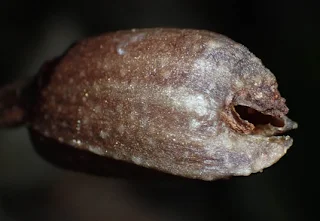
A characteristic of evolved systems is that they tend towards increasing complexity, the antithesis of an intelligently designed system, which should be minimally complex for the simple reason that complexity is expensive in terms of energy and resource, and more likely to go wrong.
Unnecessary complexity and prolific waste, which are normal components of evolved systems, are the strongest arguments against intelligent design and for a mindless, utilitarian, near-enough-is-good-enough, process such as evolution by natural selection.
And just such a case of quite ludicrous complexity has been revealed by Kenji Suetsugu of Kobe University Graduate School of Science, Kobe, Japan.
Sadly, the paper in Ecology is behind a paywall, however the research and its significance is the subject of Kobe University press release:
Fungi-eating orchids were found for the first time to offer their flowers to fungi-eating fruit flies in exchange for pollination, which is the first evidence for nursery pollination in orchids. This unique new plant-animal relationship hints at an evolutionary transition towards mutualistic symbiosis.The only discernible purpose for this system is to produce more orchids of the species, Gastrodia foetida. It's easy to see how this process evolved by natural selection because it is likely that a parasitic orchid that feeds on soil fungi would come to taste of those fungi. This in turn would attract the fruit flies that normally feed on the same fungi. It then becomes advantageous to the orchid to improve its fungal-like taste because that gets it pollen distributed more efficiently.The mutualistic relationship between Gastrodia foetida and its pollinator, both of which primarily feed on mushrooms. The flowers emit a mushroom-like smell that lures the flies in. As the flies feed on the flowers, pollen grains attach to their backs (1). When the fly leaves one flower and visits another to lay eggs, the attached pollen comes into contact with the stigma, completing pollination (2). After successful pollination, the flower starts to decay and internally hatched larvae begin consuming the petals (3). The larvae grow further by consuming the petals that have fallen to the ground (4). Approximately one week later, they emerge as adults.© ANSAI Shun (CC BY)Orchids are well known to trick their pollinators into visiting the flowers by imitating food sources, breeding grounds or even mates without actually offering anything in return. The fungi-eating, non-photosynthetic orchid genus Gastrodia is no different: To attract fruit flies (Drosophila spp.), the plants usually emit a smell like their common diet of fermented fruits or decaying mushrooms. The fruit flies get lured into the flowers, are trapped there for a short while and get pollen attached to their backs which they then transport to other plants of the same species. Thus, this deceptive relationship offers benefits to only one partner.Kobe University plant biologist SUETSUGU Kenji, a specialist on these orchids, noticed that a certain species of this genus, Gastrodia foetida, has particularly fleshy petals that decompose and fall off a few days after pollination. He decided to investigate these plants in the search for the first example of orchids engaging in “nursery pollination”, which is a plant offering a breeding ground to its pollinator. And indeed, in the study now published in the journal Ecology, he reports that fruit flies often lay their eggs into the plant’s flowers and that their larvae can fully develop into adult flies in this environment.This discovery is significant because it uncovers a new type of nursery pollination system, going beyond deceptive strategies commonly found in the genus.The most intriguing aspect is that, contrary to its common name as the 'fruit' fly, Drosophila bizonata, a species specialized in mushroom-feeding, predominantly utilizes decaying Gastrodia foetida flowers as brood sites. A possible explanation is the fact that Gastrodia foetida is a non-photosynthetic orchid that feeds on fungi. These non-photosynthetic orchids often exhibit chemical resemblance to the fungi they assimilate, underlining the age-old adage ‘You are what you eat.’ As a plant that feeds on mushrooms, G. foetida likely tastes similar to a mushroom, making it a prime target for the mushroom-specialized fruit fly.
Suetsugu KenjiThe Kobe University researcher further explains that the relationship is neither obligatory nor specific, that is, the fruit flies also lay fully developing eggs on fungi. Thus, this finding may represent an example for the transition from a deceptive relationship towards mutualistic symbiosis, suggested by two factors: the low cost to the plant, since the petals are not needed anymore after pollination; and that closely related Gastrodia dominantly utilize a deceptive strategy without providing a nursery.This study represents the first evidence of nursery pollination in orchids, comprising nearly 30,000 species, and being the most diverse plant group in the world. In addition, it contributes vital understanding to the intricate and mutually beneficial relationships that can develop in nature. The understanding of how plants can offer genuine benefits rather than merely deceiving pollinators could impact the broader study of plant-animal interactions and their evolutionary dynamics.
Sudtsugu Kenji
The fruit flies then mistake the flowers for the fungi on which they normally lay their eggs and this, fortuitously gives the developing fruit fly larvae an alternative food source, so reinforcing this behaviour.
What is incomprehensible is how this system could conceivably be regarded as the product of an intelligent designer who wanted to design a process for producing more parasitic orchids.
What Makes You So Special? From The Big Bang To You
Ten Reasons To Lose Faith: And Why You Are Better Off Without It









No comments :
Post a Comment
Obscene, threatening or obnoxious messages, preaching, abuse and spam will be removed, as will anything by known Internet trolls and stalkers, by known sock-puppet accounts and anything not connected with the post,
A claim made without evidence can be dismissed without evidence. Remember: your opinion is not an established fact unless corroborated.